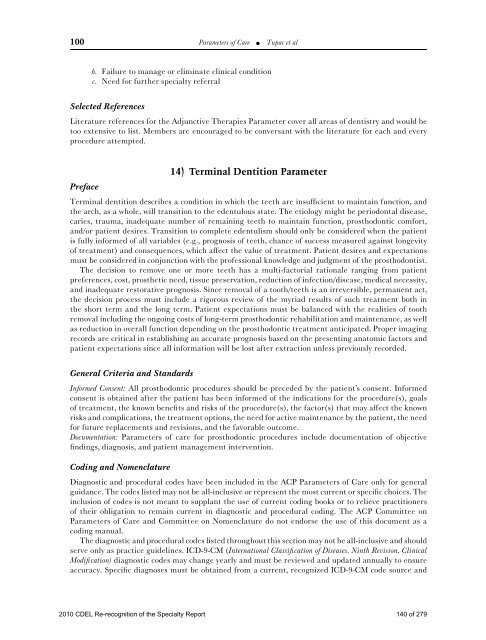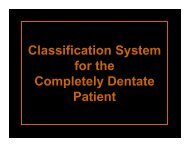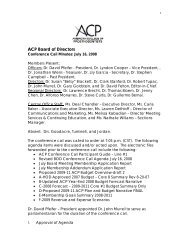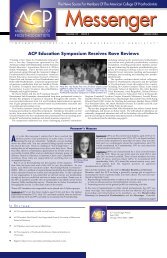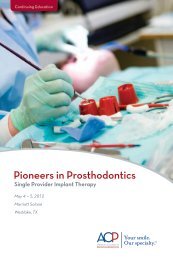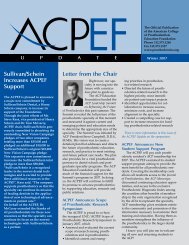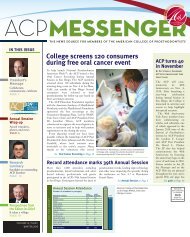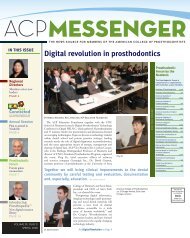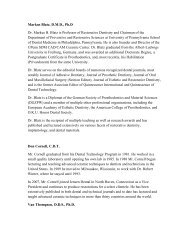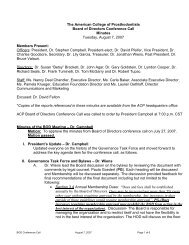PROSTHODONTICS - American College of Prosthodontists
PROSTHODONTICS - American College of Prosthodontists
PROSTHODONTICS - American College of Prosthodontists
You also want an ePaper? Increase the reach of your titles
YUMPU automatically turns print PDFs into web optimized ePapers that Google loves.
100 Parameters <strong>of</strong> Care Tupac et alb. Failure to manage or eliminate clinical conditionc. Need for further specialty referralSelected ReferencesLiterature references for the Adjunctive Therapies Parameter cover all areas <strong>of</strong> dentistry and would betoo extensive to list. Members are encouraged to be conversant with the literature for each and everyprocedure attempted.Preface14) Terminal Dentition ParameterTerminal dentition describes a condition in which the teeth are insufficient to maintain function, andthe arch, as a whole, will transition to the edentulous state. The etiology might be periodontal disease,caries, trauma, inadequate number <strong>of</strong> remaining teeth to maintain function, prosthodontic comfort,and/or patient desires. Transition to complete edentulism should only be considered when the patientis fully informed <strong>of</strong> all variables (e.g., prognosis <strong>of</strong> teeth, chance <strong>of</strong> success measured against longevity<strong>of</strong> treatment) and consequences, which affect the value <strong>of</strong> treatment. Patient desires and expectationsmust be considered in conjunction with the pr<strong>of</strong>essional knowledge and judgment <strong>of</strong> the prosthodontist.The decision to remove one or more teeth has a multi-factorial rationale ranging from patientpreferences, cost, prosthetic need, tissue preservation, reduction <strong>of</strong> infection/disease, medical necessity,and inadequate restorative prognosis. Since removal <strong>of</strong> a tooth/teeth is an irreversible, permanent act,the decision process must include a rigorous review <strong>of</strong> the myriad results <strong>of</strong> such treatment both inthe short term and the long term. Patient expectations must be balanced with the realities <strong>of</strong> toothremoval including the ongoing costs <strong>of</strong> long-term prosthodontic rehabilitation and maintenance, as wellas reduction in overall function depending on the prosthodontic treatment anticipated. Proper imagingrecords are critical in establishing an accurate prognosis based on the presenting anatomic factors andpatient expectations since all information will be lost after extraction unless previously recorded.General Criteria and StandardsInformed Consent: All prosthodontic procedures should be preceded by the patient’s consent. Informedconsent is obtained after the patient has been informed <strong>of</strong> the indications for the procedure(s), goals<strong>of</strong> treatment, the known benefits and risks <strong>of</strong> the procedure(s), the factor(s) that may affect the knownrisks and complications, the treatment options, the need for active maintenance by the patient, the needfor future replacements and revisions, and the favorable outcome.Documentation: Parameters <strong>of</strong> care for prosthodontic procedures include documentation <strong>of</strong> objectivefindings, diagnosis, and patient management intervention.Coding and NomenclatureDiagnostic and procedural codes have been included in the ACP Parameters <strong>of</strong> Care only for generalguidance. The codes listed may not be all-inclusive or represent the most current or specific choices. Theinclusion <strong>of</strong> codes is not meant to supplant the use <strong>of</strong> current coding books or to relieve practitioners<strong>of</strong> their obligation to remain current in diagnostic and procedural coding. The ACP Committee onParameters <strong>of</strong> Care and Committee on Nomenclature do not endorse the use <strong>of</strong> this document as acoding manual.The diagnostic and procedural codes listed throughout this section may not be all-inclusive and shouldserve only as practice guidelines. ICD-9-CM (International Classification <strong>of</strong> Diseases, Ninth Revision, ClinicalModification) diagnostic codes may change yearly and must be reviewed and updated annually to ensureaccuracy. Specific diagnoses must be obtained from a current, recognized ICD-9-CM code source and2010 CDEL Re-recognition <strong>of</strong> the Specialty Report 140 <strong>of</strong> 279


